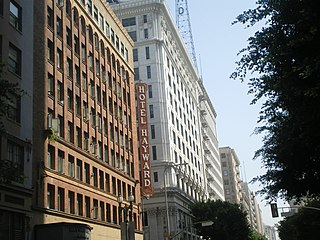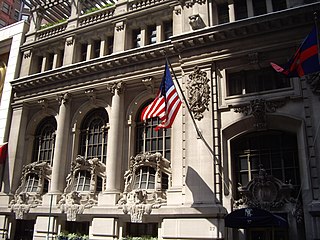
Hy-Vee Arena, previously known as Kemper Arena, is an indoor arena located in Kansas City, Missouri. Prior to conversion to a youth sports and community gymnasium facility, Kemper Arena was previously a 19,500-seat professional sports arena. It has hosted NCAA Final Four basketball games, professional basketball and hockey teams, professional wrestling events, the 1976 Republican National Convention, concerts, and is the ongoing host of the American Royal livestock show.

The Crossroads is a neighborhood within Greater Downtown with a population of 7,491. It is centered at approximately 19th Street and Baltimore Avenue, directly south of the Downtown Loop and north of Crown Center. It is the city's main art gallery district and center for the visual arts. Dozens of galleries are located in its renovated warehouses and industrial buildings. It is also home to numerous restaurants, housewares shops, architects, designers, an advertising agency, and other visual artists. The district also has several live music venue.

The Pillsbury A-Mill is a former flour mill located on the east bank of the Mississippi River in Minneapolis, Minnesota. It was the world's largest flour mill for 40 years. Completed in 1881, it was owned by the Pillsbury Company and operated two of the most powerful direct-drive waterwheels ever built, each capable of generating 1,200 horsepower . In 1901 one of the turbines was replaced with a 2,500 horsepower one. Both the mill and its headrace tunnel are contributing resources to the St. Anthony Falls Historic District, which is on the National Register of Historic Places. The mill is also independently on the NRHP. The mill was named a National Historic Landmark in 1966 and has since been converted into the A-Mill Artist Lofts.

Quality Hill is a historic neighborhood near downtown Kansas City, Missouri, USA, on a 200-foot-high bluff which overlooks the confluence of the Kansas and Missouri rivers in the West Bottoms below.

The Belmont–Sheffield Trust and Savings Bank Building is a historic building built in 1928 and located at 1001 W. Belmont Avenue, Chicago, Illinois, United States. It is listed as one of the National Register of Historic Places since 1984.

The Moxy Phoenix Downtown is a hotel located in the Luhrs Building, a historic ten-story office building located at 11 West Jefferson in Downtown Phoenix, Arizona. It was listed on the Phoenix Historic Property Register in 1990, and on the National Register of Historic Places in 2024. It was built by local businessman George H. N. Luhrs, an original Phoenix City Council member from 1881–85, at a cost of $553,000 USD, and opened on May 17, 1924. At the time, it was the tallest building in Phoenix and was said to be the largest building between El Paso and Los Angeles. In 2009, the building was renovated with the help of a $500,000 historic preservation grant.

Ward Parkway is a boulevard in Kansas City, Missouri, United States. Ward Parkway begins at Brookside Boulevard on the eastern edge of the Country Club Plaza and travels west 2.8 miles along Brush Creek as U.S. Route 56 before turning south near Kansas-Missouri state line. It continues south for 4 miles, terminating at Wornall Road near Bannister Road. A short spur, Brush Creek Parkway, connects Ward Parkway to Shawnee Mission Parkway at State Line Road.

The Library District is an officially designated neighborhood in Downtown Kansas City, Missouri, United States, roughly bounded by 9th and 11th Streets on the north and south and Main Street and Broadway on the east and west. The District contains a sub-district named the West Ninth Street/Baltimore Avenue Historic District listed on the National Register and which includes several buildings individually listed on the National Register of Historic Places. It also contains other notable structures not listed on the National Register.

Houston Hall is the student union of the University of Pennsylvania, in Philadelphia, Pennsylvania. Completed in 1896, it was the first student union built on an American college campus.

The Uptown Theater is a historic theater located in Kansas City, Missouri. The building was listed on the National Register of Historic Places in 1979 as the Uptown Building and Theater.

The A.G. Bartlett Building is a 14-floor building at 215 West Seventh Street in Downtown Los Angeles. When completed in 1911, it was the tallest building in the city for five years.

The Stuart Hall Building is located at 2121 Central Street in the Crossroads Arts District neighborhood of Kansas City, Missouri. The former commercial building is known as the Freight House Lofts or Stuart Hall Lofts.

Spring Street in Los Angeles is one of the oldest streets in the city. Along Spring Street in Downtown Los Angeles, from just north of Fourth Street to just south of Seventh Street is the NRHP-listed Spring Street Financial District, nicknamed Wall Street of the West, lined with Beaux Arts buildings and currently experiencing gentrification. This section forms part of the Historic Core district of Downtown, together with portions of Hill, Broadway, Main and Los Angeles streets.

The BMA Tower is a building in Kansas City, Missouri. Also known as One Park Place, it was built as a 19-story Modern style office building. Located on a prominent height 3 miles (4.8 km) south of downtown Kansas City, the 280 feet (85 m) building is uniquely visible. The building was planned for the Business Men's Assurance Company of America, an insurance company, on the site of the former St. Joseph's Orphanage. The building was designed by Skidmore, Owings & Merrill with steel-frame construction and clad in a contrasting grid of deeply inset black glass and white marble. It was the first high-rise structure in Kansas City since the building of City Hall in 1936, and opened in 1963.

The Santa Fe Terminal Complex is an 18-acre (73,000 m2) complex of historic buildings in the Government District of downtown Dallas, Texas (USA). Constructed in 1924 as the headquarters for the Gulf, Colorado and Santa Fe Railway and the Southwest's largest merchandising center, three of the original four buildings remain today and have been renovated into various uses. Santa Fe Buildings No. 1 and No. 2 were listed in the National Register of Historic Places in 1997, and the buildings are Dallas Landmarks. The Santa Fe Freight Terminal is regarded as one of the chief factors in the development of Dallas commercially.
The Kansas City Athletic Club is an athletic club and gentlemen's club in downtown Kansas City, Missouri. Notable members have included President Harry S. Truman and others.

The Kansas City Club, founded in 1882 and located in the Library District of Downtown Kansas City, Missouri, USA, was the oldest gentlemen's club in Missouri. The club began admitting women members in 1975. Along with the River Club on nearby Quality Hill, it was one of two surviving private city clubs on the Missouri side of Kansas City. Notable members include Presidents Harry Truman and Dwight D. Eisenhower, General Omar Bradley, and political boss Tom Pendergast. It closed in 2015.

The Broadway Hollywood Building is a building in Los Angeles' Hollywood district. The building is situated in the Hollywood Walk of Fame monument area on the southwest corner of the intersection referred to as Hollywood and Vine, marking the intersection of Hollywood Boulevard and Vine Street. It was originally built as the B. H. Dyas Building in 1927. The Broadway Hollywood Building is referred to by both its main address of 6300 Hollywood Boulevard and its side address of 1645 Vine Street.

The Imperial Brewing Company Brewery was an abandoned Late Victorian/Romanesque Revival-style industrial site located at 2825 Southwest Boulevard in downtown Kansas City, Missouri. Built in 1902, the surviving brewhouse and stable were part of a larger complex developed by Ludwig D. Breitag, a German immigrant and stone contractor. An icehouse and other buildings in the complex were demolished when the site was converted to a flour mill during Prohibition. From 1919 until its closure in the mid-1980s, Imperial Brewery became commonly known as the Boulevard Mill. The site was purchased in 2007 with plans to renovate. The site was added to the National Registry of Historic Places in 2011. Fires and vandalism halted the planned renovations in 2012. The Imperial Brewery Company Building was completely demolished in 2023.

The New York Yacht Club Building is a seven-story Beaux-Arts clubhouse at 37 West 44th Street in the Midtown Manhattan neighborhood of New York City. Opened in 1901, the building was designed by architect Whitney Warren of Warren and Wetmore as the sixth clubhouse of the New York Yacht Club (NYYC). The clubhouse is part of Clubhouse Row, a concentration of clubhouses on 44th Street between Fifth and Sixth Avenues. The building is a New York City designated landmark and is listed on the National Register of Historic Places as a National Historic Landmark.



















